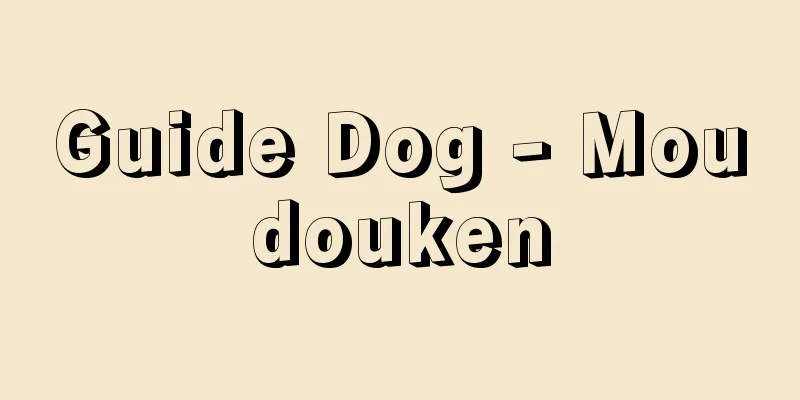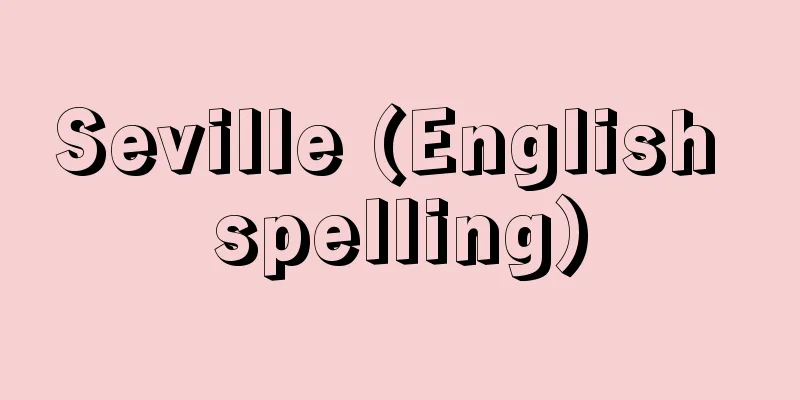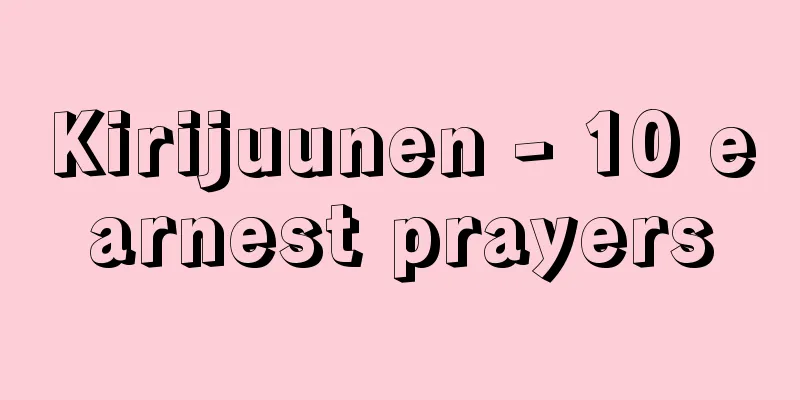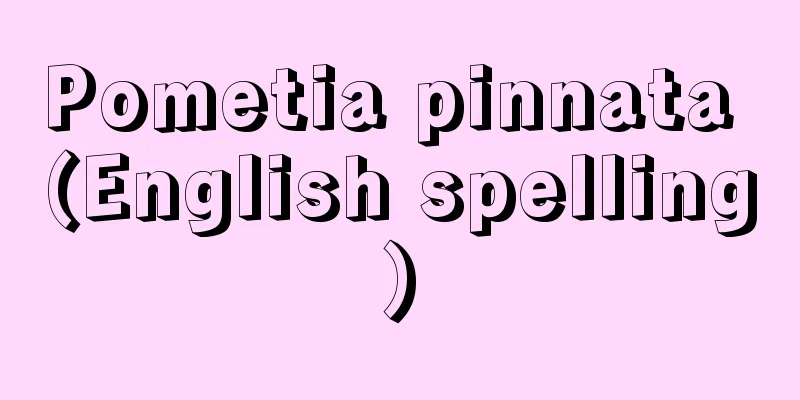Braille
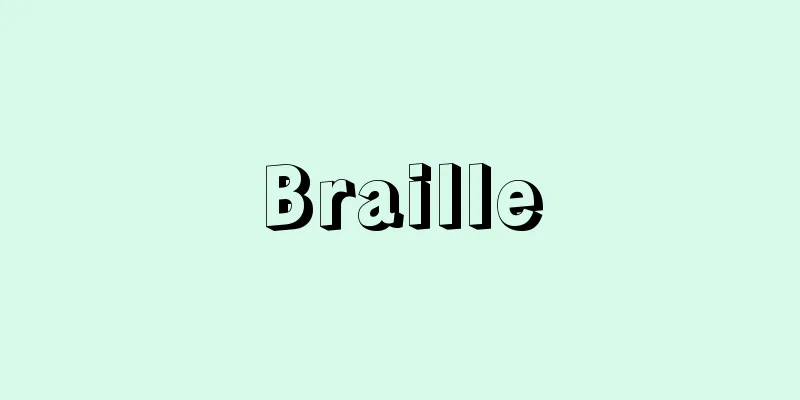
|
Braille is a writing system for visually impaired people (especially the blind), made up of raised dots that can be read by touch. The Braille system is based on 63 types of characters, which can be created by combining six dots (three dots vertically and two dots horizontally). Among those involved with the visually impaired, regular characters are often referred to as "sumiji" (printed characters) in contrast to Braille. [Masao Seo] EstablishedThe six-dot Braille system was announced in 1829 by the blind Frenchman Louis Braille (1809-1852), and was officially recognized by the government in 1854 (the French and English word for Braille is "braille"). His Braille was an improvement over the 11-dot Braille system developed for military use by French artillery officer Charles Barbier, and was made into a six-dot system that was easier for the blind to read by touch. Until then, raised line characters imitating ink characters had been used, but due to the efficiency of reading and writing and the saving of paper, Braille, which is different from regular characters, came to dominate as a writing system for the blind, and remains so to this day. In Japan, Braille was created in 1890 (Meiji 23) when the Braille Selection Committee of the Tokyo School for the Blind and Deaf (then Tokyo Moua School) adopted a proposal by the school's teacher, Ishikawa Kuraji, and it was published in the Official Gazette as "Japanese Reading Blind Braille" in 1901 (Meiji 34). Braille was officially recognized by law in 1925 (Taisho 14) and the following year with the promulgation of the House of Representatives Election Law and the Enforcement Order of that Law. [Masao Seo] Japanese BrailleUnlike foreign Braille, which is based on the alphabet, Japanese Braille is based on phonetic characters corresponding to kana, and is composed of vowels and consonants to represent the Japanese syllabary. The size of the Braille varies slightly depending on the type of Braille tool, but there are six dots, each 1.2 mm in diameter and 0.4 to 0.6 mm high, arranged in a rectangle 6 mm long and 3 mm wide. Each of these six dots is numbered. When reading (convex dots), the left column is called dots 1, 2, and 3 from the top, and the right column is called dots 4, 5, and 6 from the top. When writing (concave dots), this is reversed, with the right column being 1, 2, and 3, and the left column being dots 4, 5, and 6. When typing Braille (concave dots), the convex dots appear on the back of the paper, reversed. Tools for writing Braille are broadly divided into three types: Braille boards, portable Braille devices, and Braille typewriters. Printing methods include the traditional method of sandwiching the paper between zinc plates and applying pressure to create a rugged surface, as well as a method using foaming ink to create a rugged surface, solid braille made from polyvinyl chloride, and thermoforming, which is formed using a vacuum heat process.It is hoped that in the future computers will be used to create braille teaching materials. Braille is read using the index fingers of both hands, but it is generally considered more efficient to read using the index finger of the left hand. The principles of Braille notation can be broadly divided into (1) kana usage (how words are written), (2) word segments, and (3) punctuation. Kana usage corresponds to modern kana usage, but the writing of long vowels in the U and O rows and the particles "wa" and "he" are different, and the writing of lowercase letters such as yo-on (yo-on), sokuon (sokuon), and special sounds is difficult to correspond to Braille, so a unique writing method is used. Because braille uses kana characters, reading comprehension is difficult without segmentation. For this reason, so-called phrase segmentation is used. Long compound words within phrases may also be segmented. In principle, punctuation is the same as in general use. Symbols such as full stops, question marks, parentheses, and arrows are also used in the same way, but commas and middle marks are often used in a limited way, so special care should be taken. In addition, mathematical symbols, physicochemical symbols, and musical symbols in Braille have also been specified. The Japan Braille Committee, a private organization made up of people involved in welfare for the blind, people involved in schools for the blind, and academic experts, is playing a central role in the unification, improvement, and dissemination of Braille notation. Internationally, the World Braille Council (WBC), a committee within the World Council for the Welfare of the Blind (WCWB), has been established and is working to unify Braille symbols worldwide. [Masao Seo] English BrailleA distinctive feature of English Braille writing is the use of abbreviated characters. There are different levels depending on the degree of abbreviation use. Grade I is a full spelling out system with one-to-one correspondence with normal letters and symbols. Grade II is based on Grade I and uses an abbreviated character system with over 180 contractions and abbreviations. It is used in newspapers, magazines, textbooks, etc. and has become the standard for English Braille publications. Grade III is based on Grade II and adds even more Braille abbreviations, with over 500 types, and is used for personal use. [Masao Seo] assignmentAlthough there are many problems with Braille, research has shown that no matter how much training one undergoes, it takes three to four times as long to read Braille compared to the average person reading with their eyes. For this reason, Braille test takers for public exams such as university entrance exams and bar exams are allowed an extension of 1.5 times the standard time. The use of Braille, which differs from normal writing forms, inevitably brings with it disadvantages in terms of communication with the general public and comprehension of vocabulary. For this reason, research and development has been carried out, including attempts to create "kanji Braille," which can write Chinese characters using eight Braille dots, the introduction and use of the "Optacon," which converts visual signals into tactile signals so that blind people can read normal characters by touch, and the introduction of computers to develop devices that convert Braille to printed characters and vice versa, and the Kurzweil Reading Machine, a reading machine that automatically reads normal printed materials and converts them into audio. Furthermore, since these research and developments, computer-based Braille information processing technology has made remarkable progress, including the development of Braille input/output systems and audio output systems. In particular, the high accuracy of Braille and normal character interchange has brought the long-held dream of the visually impaired closer to reality. [Masao Seo] "The History of the Development of Braille" by Okawahara Kingo (1937, Baifukan)" ▽ "The World Encyclopedia of the Blind" edited by Uyama Yasuo et al. (1972, Japan Lighthouse)" ▽ "Standard Braille Notation Dictionary" edited by Kobayashi Kazuhiro et al. (1981, Japan Blind Welfare Research Association)" ▽ "The Trajectory of Braille Research - A Collection of Essays Commemorating Retirement" edited by Kizuka Yasuhiro (1999, Tokyo Color Printing)" ▽ "Reading with Fingers and Ears - The Japan Braille Library and Me" by Homma Kazuo (Iwanami Shinsho) [References] | |©Shogakukan "> Braille (symbol example 1) ©Shogakukan "> Braille (symbol example 2) ©Shogakukan "> Braille (symbol example 3) ©Shogakukan "> Braille (symbol example 4) Source: Shogakukan Encyclopedia Nipponica About Encyclopedia Nipponica Information | Legend |
|
点字は、触覚によって読むことが可能となるよう、凸点を組み合わせて文字体系とした、視覚障害者(とくに盲人)用の文字である。縦3点×横2点の6点の各点の組み合わせによってできる63種類を基本に点字組織を形成している。視覚障害関係者の間では、この点字に対して一般の文字のことを墨字(すみじ)ということが多い。 [瀬尾政雄] 成立6点方式の点字は、1829年フランスの盲人ルイ・ブライユLouis Braille(1809―52)によって公表され、54年に政府によって公認された(点字を表すフランス語および英語はbrailleである)。彼の点字は、同国砲兵士官シャルル・バルビエCharles Barbierが軍事用に開発した11点の点字方式を改良して6点式とし、盲人が触読しやすいものとした。それまでは、墨字を模した線文字による凸字方式が用いられていたが、読みや書きの効率性、紙面の節約などの面から、一般の文字とは異なった点字が盲人用文字としてその座を占めるようになり、現在に至っている。 日本における点字は、1890年(明治23)、当時の東京盲唖(もうあ)学校の点字撰定(せんてい)会において、同校教員石川倉次の案が採用され、1901年(明治34)には『官報』に「日本訓盲点字」として掲載された。また点字の法制上の公認は、1925年(大正14)および翌年の衆議院選挙法および同法施行令の公布によって実現した。 [瀬尾政雄] 日本の点字アルファベットを基本とする外国の点字に対し、日本の点字は、仮名に対応する表音文字を基本とし、点字の構成は母音と子音の要素を加味して五十音を表している。点字の大きさは、点字用具の種類によって多少異なるが、縦6ミリメートル、横3ミリメートルの長方形の中に、直径1.2ミリメートル、高さ0.4~0.6ミリメートルの点が6個並んでいる。この6個の点にはそれぞれ番号が付されている。読む場合(凸点)、左列の上から1の点、2の点、3の点といい、右列の上から4の点、5の点、6の点という。書く場合(凹点)には、これが反対となり、右列が1、2、3となり、左列が4、5、6の点となる。このように点字を打つ(凹点)と、凸点は紙の裏側に左右が反対になって表れてくるわけである。点字を書く用具は、点字板、携帯用点字器、点字タイプライターの3種に大別される。印刷方法には、亜鉛板に挟んでローラーにかけて紙に凹凸をつくる伝統的な方法のほかに、発泡インキで凹凸をつくる方式や塩化ビニルによる固型点字、真空熱処理形成のサーモフォームなどがあるが、将来はコンピュータ導入による点字教材作成装置の普及が望まれている。 点字の読みは、左右の人差し指を使って読むが、一般的には、左手の人差し指を使って読むほうが学習効率から望ましいとされている。 点字の表記法の原則は、(1)仮名遣い(語の書き表し方)、(2)分かち書き、(3)句読法に大別できる。仮名遣いは、現代かなづかいに対応しているが、ウ列・オ列の長音、助詞の「は」「へ」の表記が異なるほか、拗音(ようおん)、促音(そくおん)、特殊音のような小文字の表記は、点字に対応させることが困難であるため、独自の表記法を用いている。 分かち書きは、点字が仮名文字方式のため、分かち書きをしなければ読解が困難である。そのため、いわゆる文節分かち書きを行う。文節内の長い複合語についても分かち書きを行うことがある。 句読法は原則として、一般に用いられている用法と同じである。句点、疑問符、括弧(かっこ)類、矢印類などの諸記号が同様に使用されるが、読点、中点の使用については限定的な使用が多いため、とくに注意が必要である。このほか、点字の数学記号、理化学記号、音楽記号などが定められている。このような点字表記法は、盲人福祉関係者、盲学校関係者、学識経験者などによって構成されている民間の「日本点字委員会」が中心となって、点字表記に関する統一、改善、普及が行われている。国際的には、世界盲人福祉協議会World Council for the Welfare of the Blind(WCWB)内の一委員会である世界点字協議会World Blaille Council(WBC)が設置され、点字記号の世界的統一への努力が行われている。 [瀬尾政雄] 英語の点字英語の点字表記の特徴は略字表記を使用する点にある。略字の使用程度によってその段階が定められている。グレードⅠは、普通の文字や符号と1対1の対応によるフルスペルの表記方式である。グレードⅡは、グレードⅠを前提にして、180種以上の短縮や省略による略字システムで表記する。新聞、雑誌、教科書などに採用され、英語点字出版物の標準的な表記となっている。グレードⅢは、グレードⅡを前提に、さらに多くの点字略字が加えられ、その種類も500種以上といわれ、個人用として用いられる。 [瀬尾政雄] 課題点字に関する問題点は多くあるが、点字の触読の速度はどのように訓練しても、一般の人たちが目で読むのに比較して3倍から4倍の時間を要するという研究結果がある。このため、大学入学試験や司法試験などのような公的な試験の点字受験者には、規定時間の1.5倍の時間延長が認められている。 一般の文字形態とは異なる点字を使用していることは、一般社会とのコミュニケーションや語彙(ごい)の理解力などにおいて必然的な不利を伴う。このため、8点の点字構成にして漢字が表記できる「漢点字」の試みや、視覚的信号を触覚的な信号に変換して盲人が一般の文字を触読できる「オプタコン」の導入とその活用、または、コンピュータの導入による点字と墨字との相互変換装置や、一般の活字の印刷物を自動的に読み取り、音声化する読書機Kurzweil Reading Machineなどの研究開発が行われてきた。さらにこれらの研究開発以降のコンピュータによる点字情報処理技術は、点字出入力システムの開発、音声出力システムの開発など、目覚ましい進展を遂げている。とくに点字と普通文字との相互交換の高精度化は、視覚障害者の長年の夢の実現を間近なものとしている。 [瀬尾政雄] 『大川原欽吾著『点字発達史』(1937・培風館)』▽『宇山安夫他編『世界盲人百科事典』(1972・日本ライトハウス)』▽『小林一弘他編『標準点字表記辞典』(1981・日本盲人福祉研究会)』▽『木塚泰弘編著『点字研究の軌跡――退官記念論文集』(1999・東京カラー印刷)』▽『本間一夫著『指と耳で読む――日本点字図書館と私』(岩波新書)』 [参照項目] | |©Shogakukan"> 点字(記号例1) ©Shogakukan"> 点字(記号例2) ©Shogakukan"> 点字(記号例3) ©Shogakukan"> 点字(記号例4) 出典 小学館 日本大百科全書(ニッポニカ)日本大百科全書(ニッポニカ)について 情報 | 凡例 |
>>: Angel - Tenshi (English spelling) angel English
Recommend
British East India Company
The East India Company is a general term for compa...
Kineya Mitaro (5th generation)
…Lyrics by Okamura Kakiko. Music composed by Kish...
Adamawa Eastern languages
…They are subdivided into six groups: West Atlant...
Frisch, OR (English spelling) FrischOR
…In July 1938, he escaped Germany to escape perse...
Lloyd, M.
...The main features of the performances were son...
Alishan - Arisan
A mountain in central Taiwan. It is a western bra...
Psychology of religion
A general term for various schools and methods of ...
Clethrionomys rufocanus bedfordiae (English name) Clethrionomysrufocanusbedfordiae
…[Tadaaki Imaizumi] [Yoshinori Imaizumi]. … *Some...
Kiyomizu Zatō
The title of a Kyogen piece. Zatō Kyogen. A blind...
Stillbirth - Shizan (English spelling) stillbirth
This refers to childbirth when the fetus is alrea...
Dance and rejoice - Dance and rejoice
... Since the second half of the 18th century, th...
Athletics
… [concept] Sports is a general term for modern s...
Zhao Feiyan
She was the empress of Emperor Cheng (reigned 32-...
IFR - Instrument flight rules
IFR is flying according to a flight plan submitted...
Susumu Okano
…In 1931, he was elected as a member of the Centr...


